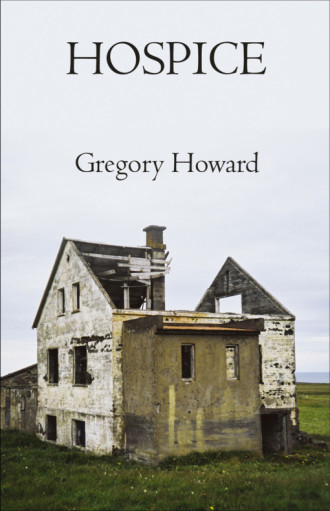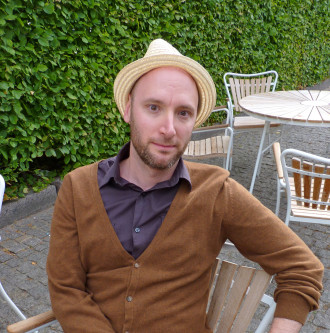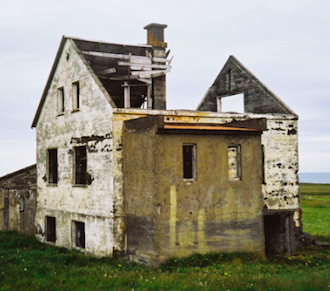A Ghost Story Without A Ghost: An Interview with Gregory Howard
09.02.16
 Gregory Howard’s Hospice (FC2) is a novel of expanding mysteries and subtle magic, delivering both an immersive story and inventive structure. Not only one of the best novels of 2015, it’s the rare debut that’s fully formed in its vision – which is even more impressive since the vision is so singular.
Gregory Howard’s Hospice (FC2) is a novel of expanding mysteries and subtle magic, delivering both an immersive story and inventive structure. Not only one of the best novels of 2015, it’s the rare debut that’s fully formed in its vision – which is even more impressive since the vision is so singular.
Part One begins: “Then she found herself caring for the memory of an old woman’s dog.”
Told in straightforward and beguiling prose, Hospice revolves around Lucy, who takes care of the old woman’s dog as well as several children. There are hospitals that appear and vanish, cloistered men living in a suburban house, and other situations that hover around the surreal. Both Lucy and the book are haunted by what’s unseen and unspoken – and these absences can be palpably felt by the reader.
I interviewed Gregory Howard via email, one question at a time, to simulate the flow of an in-person conversation.
JEFF JACKSON: I know you’re a serious cinephile — are there particular films that have shaped your sensibilities as a writer? Or suggested new possibilities that you weren’t finding in fiction?
GREGORY HOWARD: The intimacy of film is a different kind of intimacy than that of language. It’s something I love deeply, and something I’ve thought long and hard about, keep thinking about: how that closeness, you and the image, might be best translated into words, phrases, sentences.
When I was learning how to be a writer, I was steeped in film. In fact, one of the wayward jobs I had after college, one that probably confused and mortified my parents, was working at a West Coast Video. I remember the manager convinced me to take home Sante Sangre, and I don’t think I’ll ever be the same. I remember going to the Brattle to see a double feature of Performance and The Hunger. After my friend and I left, we couldn’t figure out if we’d seen something brilliant or terrible or both.
So the films I’m thinking of in particular are foreign and arthouse films, the kinds of films I mostly hadn’t seen before. There are so many I could pick. Peter Greenaway’s The Falls. Herzog’s Even Dwarfs Started Small. But the one I want to talk about, the one I think of when I think of that time and what and how I was learning is Krzysztof Kieślowski’s Double Life of Veronique.
The first three images of the film are all distorted–one is a city upside down viewed by a child, the next a leaf under a magnifying glass (held by the same child now in the country), the final a grown woman stretched as if the lens was a funhouse mirror. This is the film’s opening move! And there’s also a shot where Veronique looks at the world through a glass marble and the camera show us what that looks like–the rounded distorted world (a shot he brings back at important moments).
It was my first experience with a film that played with the idea of what cinematic image could be in this way, and this is the crux of it for me. Kieslowski’s films are so playful, even while using everything in the frame to try to bring across what he wants, even while being about deeply sad and unfulfilled lives. It was a revelation. I thought: what’s the writing equivalent to that?
JJ: Were there any films that were specifically on your mind while working on Hospice?
 GH: I watched a few things over and over, mostly as a way of keeping myself engaged in tone and a certain emotional vibration. Probably the most important one was Picnic at Hanging Rock.
GH: I watched a few things over and over, mostly as a way of keeping myself engaged in tone and a certain emotional vibration. Probably the most important one was Picnic at Hanging Rock.
It’s a film about an unexplained disappearance during a girl’s school field trip in 19th century Australia. It’s esoteric and elliptical. A ghost story without a ghost. It’s about repression and identity. Hospice is pretty much also all of these things. So I kept watching it, particularly the first twenty minutes, when I would get stuck and needed reminding about the field I wanted to play in.
I also kept Spirit of the Beehive on a loop. It’s so good at capturing the beauty and terror of childhood. The final film I watched a lot was Jim Jarmusch’s Broken Flowers. Jarmusch is great with road trips generally. But that one is just about perfect. The set pieces work together and accumulate without making overt connections and relying on typical narrative/emotional beats. I kept watching it to see again and again how set pieces can add up to something resonant.
JJ: Hospice works beautifully in terms of being a series of discrete set pieces that add up to a satisfying and complete narrative. What was your process for finding the right balance between the sections? Did you always know what these sections would include or did you write more set pieces than made it into the book?
GH: The structure of the book, how narrative can work through accumulation of incidents rather than of cause and effect is something I thought a lot about.
Hospice is a book about trauma and informed by theories about trauma, how those affected by traumatic events often circle in both obvious and strange ways the origin of their trauma without every being able to access it; how stories, multiple stories, emerge from this gap.
I wanted the book to work with these gaps in information, for Lucy and for the reader, to create a kind of space for both the character and the reader to experience this circling. Repetition via a series of vignettes seem to be ideal for this. And the three part structure–I love three-part structures–both balanced and unbalanced at the same time–also helped. To have the heart of Lucy’s story in the heart of the book, flanked by experiences that resemble each other, that repeat and don’t. This was important to me in thinking how trauma can work.
But it didn’t start out this way. The form was something I came to after writing a lot of material, a lot of which got cut. Hospice started out as something very different. In the beginning, it was a series of sketches and stories built around a strange hospital in the woods. There were all these diagnostic sections, with doctors, whose names were anagrams of each other, describing a constantly shifting disease and how it had been and would be treated. In between, there were patient stories and what became Lucy’s story, what became Hospice, was one of them.
So I cut about 80 percent of what I’d written and refocused on the story of this girl and her brother who disappeared and everything else the book became was about chasing that story until it’s end. The first thing I wrote that made me understand that I was onto something larger and longer was the first vignette in Part 2 about Lucy and her brother playing dead bodies. I knew then I was following something necessary and the rest of what I’d been writing had to be stripped away.
JJ: I love your description of Hospice as “a ghost story without a ghost.” The brother’s absence is a void that everything else swirls around. I’m curious how you approached his character.
GH: There are a few different ways to answer this. To start with, the first glimpse of the brother for me and the book came from that first section we were talking about. Playing dead bodies. What was immediately apparent to me in writing into that story was that the brother could only be present in the context of memory and desire. Because the novel is rooted in Lucy’s emotional point of view and psychic field, because the skin of the narrative displays only this p.o.v. and field, I found I could only access him through her, through loss, through assemblage.
Hospice is a sneakily autobiographical novel. While I was doing research for the book, I found an article talking about new research indicating that the relationship between sibling was now more important in terms of identity formation than the hallowed Freudian parental model, which intrigued me because it seemed to fit into my own experience of growing up with my sister. And as I thought a bit more about my relationship with my sister, and how we are very close now and were often inseparable in childhood, but that there was a period of time when I was a teenager, due to a couple different factors–a genetic legacy, a series of interpersonal traumas–that depression and an acute sense of isolation and loneliness emerged, and I kind of built a wall between myself and everyone and basically lived in my room or the basement for three years. So I thought, when I discovered this connection: push that to an extreme. Let’s take this emotional disappearance and amplify it to see its effects, its gravitational pull. It was way to look at my experience through the eyes of someone else, someone important to me. It was a way to write about fragility of self in the only way I could.
JJ: Endings are always hard, but especially for novels that are episodic and ambiguous. I’m curious what makes for a satisfying ending for you with these sort of stories?
GH: Endings are hard. What I generally want most out of an ending and especially for this kind of story is an image or language that captures the movement of the narrative and pushes it outward past the page, past the last period. The Joyce-of-Dubliners move of stopping rather than ending. Because this particular story isn’t tethered to the rigorous logic of cause-and-effect storytelling, the resonant and mysterious image is something I thought was appropriate. It’s something I love. I’m prone to the drama of stopping in mid-action. Like Fellini’s Nights of Cabiria, in which Cabiria has lost everything again and walks toward an uncertain future but, for a moment, smiles at the beauty and joy of life, how it goes on.
 JJ: I really admire the ending of Hospice. Was it something that you planned or could sense far in advance, or did you discover it fairly late in the process?
JJ: I really admire the ending of Hospice. Was it something that you planned or could sense far in advance, or did you discover it fairly late in the process?
GH: So, for Hospice, I discovered the ending midway through the process. This is how it often works for me in either short stories or longer work: suddenly, in the middle of the piece, sometimes in the middle of a sentence or paragraph, I’ll get either an image or a line that I know I’m writing towards. Then I scroll to the end of the document and write that down if it’s a line or do my best job describing it to myself if it’s an image. With Hospice, each episode started with a new document, so I could see it clearly on its own before relating it to the larger narrative. And one day I wrote out the image of Lucy in the back seat of her parent’s car, imagining the orange glow of the street lights as long arms. I didn’t know just yet how this scene was the end of the book, but I knew it was. It wasn’t until later that when I wrote her returning to the development full of show homes and that the guard Belvedere was still there that I understood how the book was going to end.
JJ: Has the experience of writing Hospice affected what you’re working on next?
GH: I’m working on a novel that takes on multiple voices, some first person, some third, and arcs through about 30 years of history with some distorted present and future for good measure. And I’m also working on a collection of short stories. Re-learning how to write in a short space after writing long has been a challenge but one that has been fun to undertake. One thing I did learn writing Hospice and try to remember is to trust myself more and get less in my own way, to hold on to the knowledge that the words and images and stories that resonate for me can resonate for others and to pursue those no matter what direction they go.